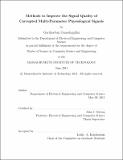| dc.contributor.advisor | John J. Guttag. | en_US |
| dc.contributor.author | Gartheeban, Ganeshapillai | en_US |
| dc.contributor.other | Massachusetts Institute of Technology. Dept. of Electrical Engineering and Computer Science. | en_US |
| dc.date.accessioned | 2011-09-27T17:28:13Z | |
| dc.date.available | 2011-09-27T17:28:13Z | |
| dc.date.copyright | 2011 | en_US |
| dc.date.issued | 2011 | en_US |
| dc.identifier.uri | http://hdl.handle.net/1721.1/65969 | |
| dc.description | Thesis (S.M.)--Massachusetts Institute of Technology, Dept. of Electrical Engineering and Computer Science, 2011. | en_US |
| dc.description | This electronic version was submitted by the student author. The certified thesis is available in the Institute Archives and Special Collections. | en_US |
| dc.description | Cataloged from student submitted PDF version of thesis. | en_US |
| dc.description | Includes bibliographical references (p. 121-125). | en_US |
| dc.description.abstract | A modern Intensive Care Unit (ICU) has automated analysis systems that depend on continuous uninterrupted real-time monitoring of physiological signals such as Electrocardiogram (ECG), Arterial Blood Pressure (ABP), and the Photo Plethysmogram (PPG). Unfortunately, these signals are often corrupted by noise, artifacts, and missing data, which can result in a high incidence of false alarms. We present a novel approach to improve the Signal Quality of a multi-parameter physiological signal by identifying the corrupted regions in the signal, and reconstructing them using the information available in correlated signals. The method is specifically designed to preserve the clinically most signicant aspects of the signals. We use template matching to jointly segment the multi-parameter signal, morphological dissimilarity to estimate the quality of the signal segment, similarity search to nd the closest match from a database of templates, and time-warping to reconstruct the corrupted segment using the matching template. Experiments carried out on the MIT-BIH Arrhythmia Database, a multi-parameter ECG database with many clinically signicant arrhythmias, demonstrate the effectiveness of the method. Our method improved the classification accuracy of the beat type by more than 700% on the signal corrupted with white Gaussian noise, and increased the similarity to the original signal, as measured by the normalized residual distance, by more than 250%. When the method was applied to the multi-parameter physiological signal data from Cinc Challenge 2010 database at Physionet.org, our method improved the classification accuracy of beat type by more than 33 times on a signal corrupted with white Gaussian noise, and increased the similarity to the original signal by more than 280%. | en_US |
| dc.description.statementofresponsibility | by Gartheeban Ganeshapillai. | en_US |
| dc.format.extent | 125 p. | en_US |
| dc.language.iso | eng | en_US |
| dc.publisher | Massachusetts Institute of Technology | en_US |
| dc.rights | M.I.T. theses are protected by
copyright. They may be viewed from this source for any purpose, but
reproduction or distribution in any format is prohibited without written
permission. See provided URL for inquiries about permission. | en_US |
| dc.rights.uri | http://dspace.mit.edu/handle/1721.1/7582 | en_US |
| dc.subject | Electrical Engineering and Computer Science. | en_US |
| dc.title | Methods to improve the signal quality of corrupted multi-parameter physiological signals | en_US |
| dc.type | Thesis | en_US |
| dc.description.degree | S.M. | en_US |
| dc.contributor.department | Massachusetts Institute of Technology. Department of Electrical Engineering and Computer Science | |
| dc.identifier.oclc | 752143269 | en_US |
